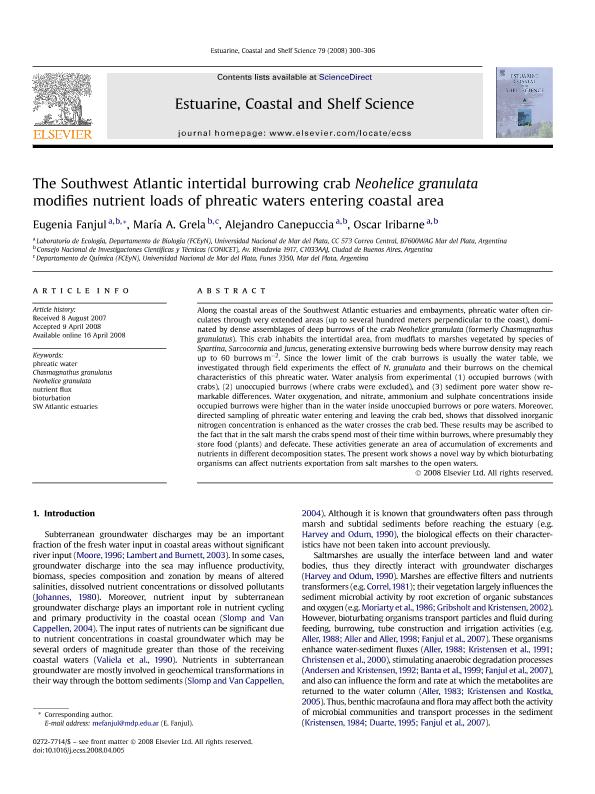Mostrar el registro sencillo del ítem
dc.contributor.author
Fanjul, Maria Eugenia

dc.contributor.author
Grela, Maria Alejandra

dc.contributor.author
Canepuccia, Alejandro Daniel

dc.contributor.author
Iribarne, Oscar Osvaldo

dc.date.available
2020-09-30T19:28:54Z
dc.date.issued
2008-08
dc.identifier.citation
Fanjul, Maria Eugenia; Grela, Maria Alejandra; Canepuccia, Alejandro Daniel; Iribarne, Oscar Osvaldo; The Southwest Atlantic intertidal burrowing crab Neohelice granulata modifies nutrient loads of phreatic waters entering coastal area; Academic Press Ltd - Elsevier Science Ltd; Estuarine, Coastal and Shelf Science; 79; 2; 8-2008; 300-306
dc.identifier.issn
0272-7714
dc.identifier.uri
http://hdl.handle.net/11336/115198
dc.description.abstract
Along the coastal areas of the Southwest Atlantic estuaries and embayments, phreatic water often circulates through very extended areas (up to several hundred meters perpendicular to the coast), dominated by dense assemblages of deep burrows of the crab Neohelice granulata (formerly Chasmagnathus granulatus). This crab inhabits the intertidal area, from mudflats to marshes vegetated by species of Spartina, Sarcocornia and Juncus, generating extensive burrowing beds where burrow density may reach up to 60 burrows m-2. Since the lower limit of the crab burrows is usually the water table, we investigated through field experiments the effect of N. granulata and their burrows on the chemical characteristics of this phreatic water. Water analysis from experimental (1) occupied burrows (with crabs), (2) unoccupied burrows (where crabs were excluded), and (3) sediment pore water show remarkable differences. Water oxygenation, and nitrate, ammonium and sulphate concentrations inside occupied burrows were higher than in the water inside unoccupied burrows or pore waters. Moreover, directed sampling of phreatic water entering and leaving the crab bed, shows that dissolved inorganic nitrogen concentration is enhanced as the water crosses the crab bed. These results may be ascribed to the fact that in the salt marsh the crabs spend most of their time within burrows, where presumably they store food (plants) and defecate. These activities generate an area of accumulation of excrements and nutrients in different decomposition states. The present work shows a novel way by which bioturbating organisms can affect nutrients exportation from salt marshes to the open waters.
dc.format
application/pdf
dc.language.iso
eng
dc.publisher
Academic Press Ltd - Elsevier Science Ltd

dc.rights
info:eu-repo/semantics/openAccess
dc.rights.uri
https://creativecommons.org/licenses/by-nc-sa/2.5/ar/
dc.subject
BIOTURBATION
dc.subject
CHASMAGNATHUS GRANULATUS
dc.subject
NEOHELICE GRANULATA
dc.subject
NUTRIENT FLUX
dc.subject
PHREATIC WATER
dc.subject
SW ATLANTIC ESTUARIES
dc.subject.classification
Ecología

dc.subject.classification
Ciencias Biológicas

dc.subject.classification
CIENCIAS NATURALES Y EXACTAS

dc.title
The Southwest Atlantic intertidal burrowing crab Neohelice granulata modifies nutrient loads of phreatic waters entering coastal area
dc.type
info:eu-repo/semantics/article
dc.type
info:ar-repo/semantics/artículo
dc.type
info:eu-repo/semantics/publishedVersion
dc.date.updated
2020-08-18T19:10:08Z
dc.journal.volume
79
dc.journal.number
2
dc.journal.pagination
300-306
dc.journal.pais
Países Bajos

dc.journal.ciudad
Amsterdam
dc.description.fil
Fil: Fanjul, Maria Eugenia. Consejo Nacional de Investigaciones Científicas y Técnicas. Centro Científico Tecnológico Conicet - Mar del Plata. Instituto de Investigaciones Marinas y Costeras. Universidad Nacional de Mar del Plata. Facultad de Ciencias Exactas y Naturales. Instituto de Investigaciones Marinas y Costeras; Argentina
dc.description.fil
Fil: Grela, Maria Alejandra. Consejo Nacional de Investigaciones Científicas y Técnicas. Centro Científico Tecnológico Conicet - Mar del Plata; Argentina. Universidad Nacional de Mar del Plata; Argentina
dc.description.fil
Fil: Canepuccia, Alejandro Daniel. Consejo Nacional de Investigaciones Científicas y Técnicas. Centro Científico Tecnológico Conicet - Mar del Plata; Argentina. Universidad Nacional de Mar del Plata; Argentina
dc.description.fil
Fil: Iribarne, Oscar Osvaldo. Consejo Nacional de Investigaciones Científicas y Técnicas. Centro Científico Tecnológico Conicet - Mar del Plata. Instituto de Investigaciones Marinas y Costeras. Universidad Nacional de Mar del Plata. Facultad de Ciencias Exactas y Naturales. Instituto de Investigaciones Marinas y Costeras; Argentina
dc.journal.title
Estuarine, Coastal and Shelf Science

dc.relation.alternativeid
info:eu-repo/semantics/altIdentifier/url/https://www.sciencedirect.com/science/article/abs/pii/S0272771408001698
dc.relation.alternativeid
info:eu-repo/semantics/altIdentifier/doi/https://doi.org/10.1016/j.ecss.2008.04.005
Archivos asociados
